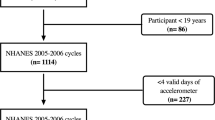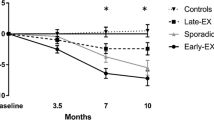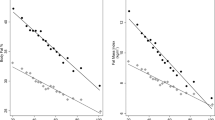Abstract
Background/objectives
Individuals successful at weight loss maintenance engage in high amounts of physical activity (PA). Understanding how and when weight loss maintainers accumulate PA within a day and across the week may inform PA promotion strategies and recommendations for weight management.
Methods
We compared patterns of PA in a cohort of weight loss maintainers (WLM, n = 28, maintaining ≥13.6 kg weight loss for ≥1 year, BMI 23.6 ± 2.3 kg/m2), controls without obesity (NC, n = 30, BMI similar to current BMI of WLM, BMI 22.8 ± 1.9 kg/m2), and controls with overweight/obesity (OC, n = 26, BMI similar to pre-weight loss BMI of WLM, 33.6 ± 5.1 kg/m2). PA was assessed during 7 consecutive days using the activPALTM activity monitor. The following variables were quantified; sleep duration, sedentary time (SED), light-intensity PA (LPA), moderate-to-vigorous intensity PA (MVPA), and steps. Data were examined to determine differences in patterns of PA across the week and across the day using mixed effect models.
Results
Across the week, WLM engaged in ≥60 min of MVPA on 73% of days, significantly more than OC (36%, p < 0.001) and similar to NC (59%, p = 0.10). Across the day, WLM accumulated more MVPA in the morning (i.e., within 3 h of waking) compared to both NC and OC (p < 0.01). WLM engaged in significantly more MVPA accumulated in bouts ≥10 min compared to NC and OC (p < 0.05). Specifically, WLM engaged in more MVPA accumulated in bouts of ≥60 min compared to NC and OC (p < 0.05).
Conclusions
WLM engage in high amounts of MVPA (≥60 min/d) on more days of the week, accumulate more MVPA in sustained bouts, and accumulate more MVPA in the morning compared to controls. Future research should investigate if these distinct patterns of PA help to promote weight loss maintenance.
This is a preview of subscription content, access via your institution
Access options
Subscribe to this journal
Receive 12 print issues and online access
$259.00 per year
only $21.58 per issue
Buy this article
- Purchase on Springer Link
- Instant access to full article PDF
Prices may be subject to local taxes which are calculated during checkout




Similar content being viewed by others
References
Donnelly JE, Blair SN, Jakicic JM, Manore MM, Rankin JW, Smith BK. American College of Sports Medicine Position Stand. Appropriate physical activity intervention strategies for weight loss and prevention of weight regain for adults. Med Sci Sports Exerc. 2009;41:459–71.
Ostendorf DM, Lyden K, Pan Z, Wyatt HR, Hill JO, Melanson EL, et al. Objectively Measured Physical Activity and Sedentary Behavior in Successful Weight Loss Maintainers. Obesity. 2018;26:53–60.
Jakicic JM, Tate DF, Lang W, Davis KK, Polzien K, Neiberg RH, et al. Objective physical activity and weight loss in adults: the step‐up randomized clinical trial. Obesity. 2014;22:2284–92.
Klem ML, Wing RR, McGuire MT, Seagle HM, Hill JO. A descriptive study of individuals successful at long-term maintenance of substantial weight loss. Am J Clin Nutr. 1997;66:239–46.
Phelan S, Roberts M, Lang W, Wing RR. Empirical evaluation of physical activity recommendations for weight control in women. Med Sci Sports Exerc. 2007;39:1832–6.
Jakicic JM, Marcus BH, Lang W, Janney C. Effect of exercise on 24-month weight loss maintenance in overweight women. Arch Intern Med. 2008;168:1550–9.
Jakicic JM, Winters C, Lang W, Wing RR. Effects of intermittent exercise and use of home exercise equipment on adherence, weight loss, and fitness in overweight women: a randomized trial. JAMA. 1999;282:1554–60.
Fogelholm M, Stallknecht B, Van Baak M. ECSS position statement: exercise and obesity. Eur J Sport Sci. 2006;6:15–24.
Saris WH, Blair SN, van Baak MA, Eaton SB, Davies PS, Di Pietro L, et al. How much physical activity is enough to prevent unhealthy weight gain? Outcome of the IASO 1st Stock Conference and consensus statement. Obes Rev. 2003;4:101–14.
Lee IM, Sesso HD, Oguma Y, Paffenbarger RS Jr. The “weekend warrior” and risk of mortality. Am J Epidemiol. 2004;160:636–41.
O’Donovan G, Lee IM, Hamer M, Stamatakis E. Association of “Weekend Warrior” and Other Leisure Time Physical Activity Patterns With Risks for All-Cause, Cardiovascular Disease, and Cancer Mortality. JAMA Intern Med. 2017;177:335–42.
Shiroma EJ, Lee IM, Schepps MA, Kamada M, Harris TB. Physical Activity Patterns and Mortality: the Weekend Warrior and Activity Bouts. Med Sci Sports Exerc. 2019;51:35–40.
Willis EA, Creasy SA, Honas JJ, Melanson EL, Donnelly JE. The effects of exercise session timing on weight loss and components of energybalance: midwest exercise trial 2. Int J Obes (Lond). 2020;44:114–124.
Alizadeh Z, Younespour S, Rajabian Tabesh M, Haghravan S. Comparison between the effect of 6 weeks of morning or evening aerobic exercise on appetite and anthropometric indices: a randomized controlled trial. Clin Obes. 2017;7:157–65.
Ezagouri S, Zwighaft Z, Sobel J, Baillieul S, Doutreleau S, Ladeuix B, et al. Physiological and Molecular Dissection of Daily Variance in Exercise Capacity. Cell Metab. 2019;30:78–91. e4
Schumacher LM, Thomas JG, Raynor HA, Rhodes RE, O’Leary KC, Wing RR, et al. Relationship of Consistency in Timing of Exercise Performance and Exercise Levels Among Successful Weight Loss Maintainers. Obesity (Silver Spring, Md). 2019;27:1285–91.
Jakicic JM, Marcus BH, Gallagher KI, Napolitano M, Lang W. Effect of exercise duration and intensity on weight loss in overweight, sedentary women: a randomized trial. JAMA. 2003;290:1323–30.
Creasy SA, Lang W, Tate DF, Davis KK, Jakicic JM. Pattern of Daily Steps is Associated with Weight Loss: secondary Analysis from the Step-Up Randomized Trial. Obesity (Silver Spring, Md). 2018;26:977–84.
Physical Activity Guidelines Advisory Committee. Physical activity guidelines advisory committee report, 2008. Washington, DC: US Deparment of Health and Human Services; 2008. p. A1–H14.
US Department of Health and Human Services. Physical Activity Guidelines for Americans, 2nd ed. Washington, DC: US Department of Health and Human Services; 2018.
De Jong NP, Rynders CA, Goldstrohm DA, Pan Z, Lange AH, Mendez C, et al. Effect of frequent interruptions of sedentary time on nutrient metabolism in sedentary overweight male and female adults. J Appl Physiol (Bethesda, Md: 1985). 2019;126:984–92.
Dunstan DW, Kingwell BA, Larsen R, Healy GN, Cerin E, Hamilton MT, et al. Breaking up prolonged sitting reduces postprandial glucose and insulin responses. Diabetes Care. 2012;35:976–83.
Fan JX, Brown BB, Hanson H, Kowaleski-Jones L, Smith KR, Zick CD. Moderate to vigorous physical activity and weight outcomes: does every minute count? Am J Health Promot. 2013;28:41–9.
Saint-Maurice PF, Troiano RP, Matthews CE, Kraus WE. Moderate-to-Vigorous Physical Activity and All-Cause Mortality: Do Bouts Matter? J Am HeartAssoc. 2018;7:e007678. https://doi.org/10.1161/JAHA.117.007678. Erratum in: J Am Heart Assoc. 2018.
Jakicic JM, Kraus WE, Powell KE, Campbell WW, Janz KF, Troiano RP, et al. Association between Bout Duration of Physical Activity and Health: systematic Review. Med Sci Sports Exerc. 2019;51:1213–9.
Thomson CA, Morrow KL, Flatt SW, Wertheim BC, Perfect MM, Ravia JJ, et al. Relationship between sleep quality and quantity and weight loss in women participating in a weight-loss intervention trial. Obesity (Silver Spring, Md). 2012;20:1419–25.
Creasy SA, Rynders CA, Bergouignan A, Kealey EH, Bessesen DH. Free-Living Responses in Energy Balance to Short-Term Overfeeding in Adults Differing in Propensity for Obesity. Obesity (Silver Spring, Md). 2018;26:696–702.
Ostendorf DM, Caldwell AE, Creasy SA, Pan Z, Lyden K, Bergouignan A, et al. Physical Activity Energy Expenditure and Total Daily Energy Expenditure in Successful Weight Loss Maintainers. Obesity (Silver Spring, Md). 2019;27:496–504.
Ostendorf DM, Melanson EL, Caldwell AE, Creasy SA, Pan Z, MacLean PS, et al. No consistent evidence of a disproportionately low resting energy expenditure in long-term successful weight-loss maintainers. Am J Clin Nutr. 2018;108:658–66.
Jakicic JM, Wing RR, Butler BA, Robertson RJ. Prescribing exercise in multiple short bouts versus one continuous bout: effects on adherence, cardiorespiratory fitness, and weight loss in overweight women. Int J Obes Relat Metab Disord. 1995;19:893–901.
Perneger TV. What’s wrong with Bonferroni adjustments. Bmj. 1998;316:1236–8.
Butts NK, Dodge C, McAlpine M. Effect of stepping rate on energy costs during StairMaster exercise. Med Sci Sports Exerc. 1993;25:378–82.
MacDonald MJ, Fawkner SG, Niven AG, Rowe D. Real World, Real People: can We Assess Walking on a Treadmill to Establish Step Count Recommendations in Adolescents? Pediatr Exerc Sci. 2019;31:488–94.
Brooker PG, Gomersall SR, King NA, Leveritt MD. The feasibility and acceptability of morning versus evening exercise for overweight and obese adults: a randomized controlled trial. Contemp Clin Trials Commun. 2019;14:100320.
Ross KM, Graham Thomas J, Wing RR. Successful weight loss maintenance associated with morning chronotype and better sleep quality. J Behav Med. 2016;39:465–71.
O’Brien MW, Johns JA, Fowles JR, Kimmerly DS. Validity of the activPAL and Height-Adjusted Curvilinear Cadence-METs Equations in Healthy Adults. Meas Phys Educ Exerc Sci. 2020;24:147–56.
Acknowledgements
The primary funding source for this study was K23 DK078913 (PI Catenacci). In addition, the Colorado Nutrition and Obesity Research Center P30 DK048520 and the Colorado Clinical and Translational Sciences Institute UL1 TR002535 provided resources and support. SAC is supported by an NIH award (K01 HL145023) as is DMO (F32 DK122652). VAC designed the study, wrote the protocol, and acquired the data. SAC, PRH, EC, and KL processed and summarized the data. SAC, PRH, EC, KL, DMO, EAW, ZP, ELM, and VAC interpreted the data, generated tables and figures, and wrote, revised, and approved the final paper. We would like to thank Rena R. Wing, PhD, James O. Hill, PhD, and Holly R. Wyatt, MD, for assisting with the original design and recruitment of this this study, as well as providing mentorship.
Author information
Authors and Affiliations
Corresponding author
Ethics declarations
Conflict of interest
This study was supported by the following NIH grant funding: K23 DK078913 (PI Catenacci), K01 HL145023 (PI Creasy), F32 DK122652 (PI Ostendorf), P30 DK048520, and UL1 TR002535. ELM is supported by resources from the Geriatric Research, Education, and the Clinical Center at the Denver VA Medical Center. The contents do not represent the views of the U.S. Department of Veterans Affairs or the United States Government. Authors have nothing else to disclose.
Additional information
Publisher’s note Springer Nature remains neutral with regard to jurisdictional claims in published maps and institutional affiliations.
Rights and permissions
About this article
Cite this article
Creasy, S.A., Hibbing, P.R., Cotton, E. et al. Temporal patterns of physical activity in successful weight loss maintainers. Int J Obes 45, 2074–2082 (2021). https://doi.org/10.1038/s41366-021-00877-4
Received:
Revised:
Accepted:
Published:
Issue Date:
DOI: https://doi.org/10.1038/s41366-021-00877-4
This article is cited by
-
Effect of sleep on weight loss and adherence to diet and physical activity recommendations during an 18-month behavioral weight loss intervention
International Journal of Obesity (2022)



